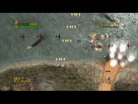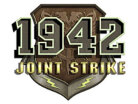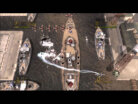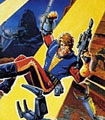- CLASSIC MAGAZINES
- REVIEW CREW
A show recapping what critics thought back
when classic games first came out! - NEXT GENERATION'S BEST & WORST
From the worst 1-star reviews to the best
5-stars can offer, this is Next Generation! - NINTENDO POWER (ARCHIVE)
Experience a variety of shows looking at the
often baffling history of Nintendo Power! - MAGAZINE RETROSPECTIVE
We're looking at the absolutely true history of
some of the most iconic game magazines ever! - SUPER PLAY'S TOP 600
The longest and most ambitious Super NES
countdown on the internet! - THEY SAID WHAT?
Debunking predictions and gossip found
in classic video game magazines! - NEXT GENERATION UNCOVERED
Cyril is back in this spin-off series, featuring the
cover critic review the art of Next Generation! - HARDCORE GAMER MAGAZING (PDF ISSUES)
Download all 36 issues of Hardcore Gamer
Magazine and relive the fun in PDF form!
- REVIEW CREW
- ELECTRONIC GAMING MONTHLY
- ELECTRONIC GAMING MONTHLY RANKS
From Mario to Sonic to Street Fighter, EGM
ranks classic game franchises and consoles! - ELECTRONIC GAMING MONTHLY BEST & WORST
Counting down EGM’s best and worst reviews
going year by year, from 1989 – 2009! - ELECTRONIC GAMING BEST & WORST AWARDS
11-part video series chronicling the ups and
downs of EGM’s Best & Worst Awards!
- ELECTRONIC GAMING MONTHLY RANKS
- GAME HISTORY
- GAME OVER: STORY BREAKDOWNS
Long-running series breaking down game
stories and analyzing their endings! - A BRIEF HISTORY OF GAMING w/ [NAME HERE]
Real history presented in a fun and pithy
format from a variety of game historians! - THE BLACK SHEEP
A series looking back at the black sheep
entries in popular game franchises! - INSTANT EXPERT
Everything you could possibly want to know
about a wide variety of gaming topics! - FREEZE FRAME
When something familiar happens in the games
industry, we're there to take a picture! - I'VE GOT YOUR NUMBER
Learn real video game history through a series
of number-themed episodes, starting at zero! - GREAT MOMENTS IN BAD ACTING
A joyous celebration of some of gaming's
absolute worst voice acting!
- GAME OVER: STORY BREAKDOWNS
- POPULAR SHOWS
- DG NEWS w/ LORNE RISELEY
Newsman Lorne Riseley hosts a regular
series looking at the hottest gaming news! - REVIEW REWIND
Cyril replays a game he reviewed 10+ years
ago to see if he got it right or wrong! - ON-RUNNING FEUDS
Defunct Games' longest-running show, with
editorials, observations and other fun oddities! - DEFUNCT GAMES QUIZ (ARCHIVE)
From online quizzes to game shows, we're
putting your video game knowledge to the test!- QUIZ: ONLINE PASS
Take a weekly quiz to see how well you know
the news and current gaming events! - QUIZ: KNOW THE GAME
One-on-one quiz show where contestants
find out if they actually know classic games! - QUIZ: THE LEADERBOARD
Can you guess the game based on the classic
review? Find out with The Leaderboard!
- QUIZ: ONLINE PASS
- DEFUNCT GAMES VS.
Cyril and the Defunct Games staff isn't afraid
to choose their favorite games and more! - CYRIL READS WORLDS OF POWER
Defunct Games recreates classic game
novelizations through the audio book format!
- DG NEWS w/ LORNE RISELEY
- COMEDY
- GAME EXPECTANCY
How long will your favorite hero live? We crunch
the numbers in this series about dying! - VIDEO GAME ADVICE
Famous game characters answer real personal
advice questions with a humorous slant! - FAKE GAMES: GUERILLA SCRAPBOOK
A long-running series about fake games and
the people who love them (covers included)! - WORST GAME EVER
A contest that attempts to create the worst
video game ever made, complete with covers! - LEVEL 1 STORIES
Literature based on the first stages of some
of your favorite classic video games! - THE COVER CRITIC
One of Defunct Games' earliest shows, Cover
Critic digs up some of the worst box art ever! - COMMERCIAL BREAK
Take a trip through some of the best and
worst video game advertisements of all time! - COMIC BOOK MODS
You've never seen comics like this before.
A curious mix of rewritten video game comics!
- GAME EXPECTANCY
- SERIES ARCHIVE
- NINTENDO SWITCH ONLINE ARCHIVE
A regularly-updated list of every Nintendo
Switch Online release, plus links to review! - PLAYSTATION PLUS CLASSIC ARCHIVE
A comprehensive list of every PlayStation
Plus classic release, including links! - RETRO-BIT PUBLISHING ARCHIVE
A regularly-updated list of every Retro-Bit
game released! - REVIEW MARATHONS w/ ADAM WALLACE
Join critic Adam Wallace as he takes us on a
classic review marathon with different themes!- DEFUNCT GAMES GOLF CLUB
Adam Wallace takes to the links to slice his way
through 72 classic golf game reviews! - 007 IN PIXELS
Adam Wallace takes on the world's greatest spy
as he reviews 15 weeks of James Bond games! - A SALUTE TO VAMPIRES
Adam Wallace is sinking his teeth into a series
covering Castlevania, BloodRayne and more! - CAPCOM'S CURSE
Adam Wallace is celebrating 13 days of Halloween
with a line-up of Capcom's scariest games! - THE FALL OF SUPERMAN
Adam Wallace is a man of steel for playing
some of the absolute worst Superman games! - THE 31 GAMES OF HALLOWEEN
Adam Wallace spends every day of October afraid
as he reviews some of the scariest games ever! - 12 WEEKS OF STAR TREK
Adam Wallace boldly goes where no critic has
gone before in this Star Trek marathon!
- DEFUNCT GAMES GOLF CLUB
- DAYS OF CHRISTMAS (ARCHIVE)
Annual holiday series with themed-episodes
that date all the way back to 2001!- 2015: 30 Ridiculous Retro Rumors
- 2014: 29 Magazines of Christmas
- 2013: 29 Questionable Power-Ups of Christmas
- 2012: 34 Theme Songs of Christmas
- 2011: 32 Game Endings of Christmas
- 2010: 31 Bonus Levels of Christmas
- 2009: 30 Genres of Christmas
- 2008: 29 Controls of Christmas
- 2007: 34 Cliches of Christmas
- 2006: 33 Consoles of Christmas
- 2005: 32 Articles of Christmas
- 2004: 31 Websites of Christmas
- 2003: 29 Issues of Christmas
- 2002: 28 Years of Christmas
- 2001: 33 Days of Christmas
- NINTENDO SWITCH ONLINE ARCHIVE
- REVIEW ARCHIVE
- FULL ARCHIVE
1942: Joint Strike
They say you can't teach an old dog new tricks but some of the innovations made in 1942: Joint Strike prove that even now, decades later, you can find new life in an age old genre. 1942: Joint Strike is a top down shooter based on the Capcom pedigree of the same name. The 194X series, at its core, is a game wherein two players take control of World War II-era planes and go to town on their opposition. To this effect, the game succeeds in being a fun, albeit an entirely too short romp through five levels. Fortunately, despite the short length, several factors can increase the re-playability for those who are willing to pursue such things.
This particular review is written on the PlayStation 3 incarnation of the game, and thusly all the matchmaking was provided by the Playstation Network. The netcode is fine once in game, but actually getting a game running can take a few tries. Aside from this, no other bugs were encountered.

Starting the game, the player or players is given the choice of three planes to choose from. One is balanced, while the other two either lean more towards health or speed, in both cases sacrificing an abundance of one stat for a deficit of the other. Surprisingly, this statistical difference is portrayed very well in game, with the faster plane (Shinden) being incredibly fast, but taking only three to five hits to kill, and the higher health (Mosquito) being notoriously hard to shoot down. This variety is refreshing and, although sometimes annoying having your plane of choice chosen by your buddy, the option to play as the balanced plane (Lightning) is a decent alternative.
Along with the variety in the planes actually making a substantial difference, the differing weapons, while not particularly innovative, do provide sufficient when shooting down droves of enemy air and ground units. Again, fairly standard, but the game offers you a diagonal spread fire, a concentrated laser, and a weapon that fires straight forward with multiple projectiles (essentially an upgraded version of your standard weapon) and all of these can be upgraded, typically increasing firing speed as well as projectile amount and damage. One thing worth noting is that because of the weapon design your flanks are often very vulnerable. While not particularly life threatening, it can pose hazardous in the later stages and higher difficulties as the enemies are quite plentiful.
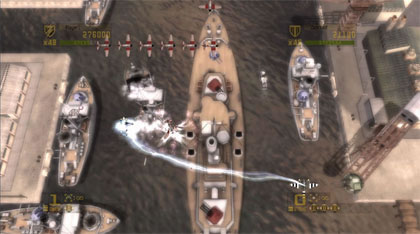
As far as the level design goes, it's about what you would expect from a top down shooter with a few twists thrown in. The first of these occurs at the end of the first stage as you are forced to fly into the screen, in an attempt to outrun your pursuer. It's interesting if nothing else, and a bit disorienting if you aren't ready for it when it happens. Graphically, the levels are pretty enough. While you fight above, the lower plane typically houses some arbitrary action as the battle rages on below you. It does a good job of keeping the levels looking alive without becoming too intrusive.
Enemy design is standard fare for the genre, including essentially reusing a single boss multiple times. The enemy AI is designed to the same pattern-centric mindset that has built this genre, and it shows. Thankfully, this is mostly absolved by the game's unique scoring mechanics (the closer you are to an enemy, the more points you get when it dies) and team based attacks, which, when used correctly can create a very fun and hectic experience.
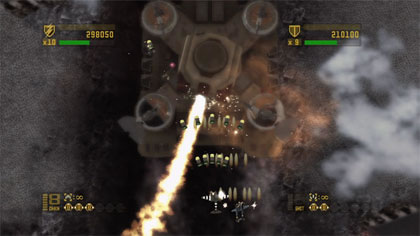
Essentially, while you aren't playing alone you have a special attack gauge that builds as you down enemies. As it builds you can fire it off, keeping a decent stack of them for later use. This special attack is chosen at the beginning of the game, and it's only in multiplayer that it really shines. When you and your buddy take to the skies, the special attack, or titular "Joint Strike" allows you to attack between your two planes. Either a lightning coil, stream of bullets or even just a large bomb can be produced and, depending on the distance between the two planes, this attack will do a scaling amount of damage/cover a larger blast radius. This mechanic is well used, as, since your flanks are typically vulnerable, you and your wingmen can stand to make a mistake once and a while, or even set up a larger blast that takes out multiple enemies (the bomb type, when stretched fully, essentially emulates the actual bombs you have to clear the screen).
While I've been quite positive, there are a few kinks in the game taken as a whole. First, the game is short. Multiple difficulties help soften the blow, but this game can be completed in under an hour. Second, the difficulty can be inconsistent. While this is only preference, I found the first two stages harder than the final three. To be fair however, the difficulty is consistent with the difficulty level chosen at the beginning, though it is worth noting that the hardest difficulty level is quite hard and a worthy homage to those that came before it in the genre as a result.
Overall, 1942: Joint Strike is a fun game for an evening, or if you're a fan of the shoot-em-up genre. While it may be lacking in content (missing even short cutscenes to set up the levels), it does have a unique scoring mechanic as well as the fun implementation of team based attacks. It might not be keep you busy for the summer, but with a buddy it can prove to provide a fun evening.
HOME |
CONTACT |
NOW HIRING |
WHAT IS DEFUNCT GAMES? |
NINTENDO SWITCH ONLINE |
RETRO-BIT PUBLISHING
Retro-Bit |
Switch Planet |
The Halcyon Show |
Same Name, Different Game |
Dragnix |
Press the Buttons
Game Zone Online | Hardcore Gamer | The Dreamcast Junkyard | Video Game Blogger
Dr Strife | Games For Lunch | Mondo Cool Cast | Boxed Pixels | Sega CD Universe | Gaming Trend
Game Zone Online | Hardcore Gamer | The Dreamcast Junkyard | Video Game Blogger
Dr Strife | Games For Lunch | Mondo Cool Cast | Boxed Pixels | Sega CD Universe | Gaming Trend
Copyright © 2001-2025 Defunct Games
All rights reserved. All trademarks are properties of their respective owners.
All rights reserved. All trademarks are properties of their respective owners.






